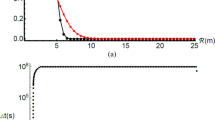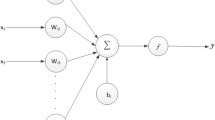Abstract
It needs long time to predict radioactive contaminant diffusion in receiving water under accident condition by using computational fluid dynamics (CFD) model. In order to shorten the computation time, a hybrid model based on CFD and time series neural network (TSNN) is proposed in this paper. The concentration change of radioactive contamination in an inland reservoir after a postulated accident is studied as a case. The result shows that this hybrid model can predict the contaminant diffusion trend and shorten at least 50% of iteration time. Priori knowledge integrated into the neural network model is able to reduce the mean square error of network output to 9.66×10−8, which makes neural network output more close to the simulated contaminant concentration.
Similar content being viewed by others
References
Thiessen K M, Thorne M C, Maul P R, et al. Modelling radionuclide distribution and transport in the environment[J]. Environmental Pollution, 1999, 100(1): 151–177.
Zheleznyak M, Potempski S, Bezhenar R, et al. Hydrological dispersion module of JRODOS: Development and pilot implementation-the vistula river basin[J]. Radioprotection, 2010, 45(5): S113-S122.
Davis P. Special issue: BIOMOVS II[J]. Journal of Environmental Radioactivity, 1999, 42(2/3): 115–116(Ch).
Wu G Z, Xu Z. Transport processes of low-level radioactive liquid effluent of nuclear power station in closed water body [J]. Environmental Science, 2012, 33(7): 2438–2443.
Qian A G, Duan J H, Ji P. Three dimensional modeling of radionuclide effluent flow in reservoir for nuclear power station[ J]. Journal of Hydroaulic Engineering, 2007, 38(12): 1495–1499(Ch).
Hu T S, Yuan P. Applications of artificial neural network to hydrology and water resources [J]. Advances in Water Science, 1995, 6(1):76–82(Ch).
Li W J. Application Research on Improved BP Neural Network for Water Quality Evaluation [D]. Chongqing: Chongqing University of Technology, 2011(Ch).
Joerding W H, Meador J L. Encoding a priori information in feedforward networks[J]. Neural Networks, 1991, 4(6): 847–856.
Thompson M L, Kramer M A. Modeling chemical processes using priori knowledge and neural networks[J]. AICHE Journal, 1994, 40(8): 1328–1340.
Shi B H, Zhu X F, Chen J W. Neural-network modeling of coagulation sedimentation process based on priori know-ledge[J]. Journal of South China University of Technology (Natural Science Edition), 2008, 36(5):113–118(Ch).
Zhang G P. Time series forecasting using a hybrid ARIMA and neural network model[J]. Neurocomputing, 2003, 50(10): 159–175(Ch).
Author information
Authors and Affiliations
Corresponding author
Additional information
Foundation item: Supported by the National Natural Science Foundation of China (51339004, 71171151)
Biography: ZHOU Yanchen, male, Ph. D. candidate, research direction: numerical simulation and water resources optimal allocation.
Rights and permissions
About this article
Cite this article
Zhou, Y., Hu, T. Application of neural network in prediction of radionuclide diffusion in receiving water. Wuhan Univ. J. Nat. Sci. 20, 73–78 (2015). https://doi.org/10.1007/s11859-015-1061-5
Received:
Published:
Issue Date:
DOI: https://doi.org/10.1007/s11859-015-1061-5
Key words
- inland nuclear accident
- radionuclide diffusion
- computational fluid dynamics
- priori knowledge
- time series neural network




